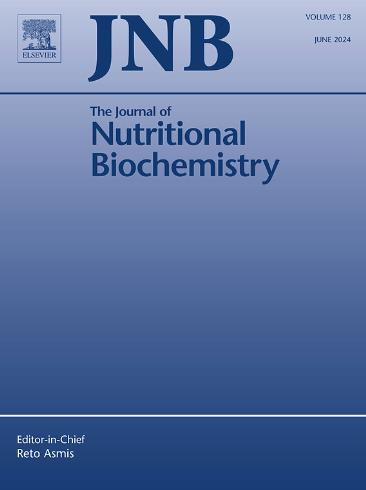Investigation of competitive binding of the essential trace elements zinc, iron, copper, and manganese by gastrointestinal mucins and the effect on their absorption in vitro
IF 4.8
2区 医学
Q1 BIOCHEMISTRY & MOLECULAR BIOLOGY
引用次数: 0
Abstract
The molecular mechanism by which the essential trace elements (TEs) zinc (Zn), iron (Fe), copper (Cu), and manganese (Mn) interact during their uptake, particularly their competition for interaction with the gastrointestinal mucus layer, remains unclear. Thus, in this study we investigated the binding of TEs to gastrointestinal mucins individually and interdependently and analyzed the impact of mucus on their intestinal absorption. Cell-free binding and competition experiments with commercially available mucin and native MUC2 and MUC5AC from porcine gastrointestinal tract showed high TE-binding capacity (Fe>Zn>Cu>Mn) with an average affinity that was highest for Zn and lowest for Mn (Zn>Fe>Cu>Mn). Gastrointestinal mucins contain high-affinity TE-binding sites with physiologically relevant affinities, and TEs mutually affected their interaction with mucins in ratios reflecting the in vivo situation, leading to various cases of displacement or augmented binding. Solely Fe was unaffected by other TEs, apart from Mn that facilitated the Fe-mucin interaction. The relevance of TE-binding by the mucins was underlined by transport studies with two 3D in vitro intestinal models: Caco-2 mono- and Caco-2/HT-29-MTX co-cultures, showing that at least for Fe and Zn, mucus provides a buffering system and increases the availability of the TEs by delivering them to the underlying enterocytes. This study provides the first systematic analysis of the competition between Zn, Fe, Cu, and Mn for binding to gastrointestinal mucins, demonstrating the importance of the mucus layer for TE absorption and that competition for their intestinal uptake already starts at the mucus barrier, with translational relevance for nutrition and (malabsorption) diseases.
胃肠粘蛋白与必需微量元素锌、铁、铜、锰的竞争结合及其体外吸收影响的研究。
必需微量元素(TEs)锌(Zn)、铁(Fe)、铜(Cu)和锰(Mn)在摄取过程中相互作用的分子机制,特别是它们与胃肠道黏液层相互作用的竞争机制尚不清楚。因此,在本研究中,我们单独和相互依赖地研究了TEs与胃肠道粘蛋白的结合,并分析了粘液对其肠道吸收的影响。与市购粘蛋白和猪胃肠道天然MUC2和MUC5AC的无细胞结合和竞争实验表明,te结合能力高(Fe>Zn>Cu b> Mn),平均亲和力对Zn最高,对Mn最低(Zn>Fe>Cu>Mn)。胃肠道粘蛋白含有高亲和力te结合位点,具有生理上相关的亲和力,te以反映体内情况的比例相互影响其与粘蛋白的相互作用,导致各种移位或增强结合的情况。除了Mn促进Fe-粘蛋白相互作用外,只有Fe不受其他te的影响。两种3D体外肠道模型(Caco-2单培养和Caco-2/HT-29-MTX共培养)的转运研究强调了黏素与te结合的相关性,表明至少对于铁和锌,黏液提供了一个缓冲系统,并通过将它们递送到底层肠细胞来增加te的可用性。本研究首次系统分析了锌、铁、铜和锰与胃肠道粘蛋白结合的竞争,证明了黏液层对TE吸收的重要性,以及它们在肠道吸收的竞争已经开始于黏液屏障,与营养和(吸收不良)疾病的转化相关。
本文章由计算机程序翻译,如有差异,请以英文原文为准。
求助全文
约1分钟内获得全文
求助全文
来源期刊

Journal of Nutritional Biochemistry
医学-生化与分子生物学
CiteScore
9.50
自引率
3.60%
发文量
237
审稿时长
68 days
期刊介绍:
Devoted to advancements in nutritional sciences, The Journal of Nutritional Biochemistry presents experimental nutrition research as it relates to: biochemistry, molecular biology, toxicology, or physiology.
Rigorous reviews by an international editorial board of distinguished scientists ensure publication of the most current and key research being conducted in nutrition at the cellular, animal and human level. In addition to its monthly features of critical reviews and research articles, The Journal of Nutritional Biochemistry also periodically publishes emerging issues, experimental methods, and other types of articles.
 求助内容:
求助内容: 应助结果提醒方式:
应助结果提醒方式:


